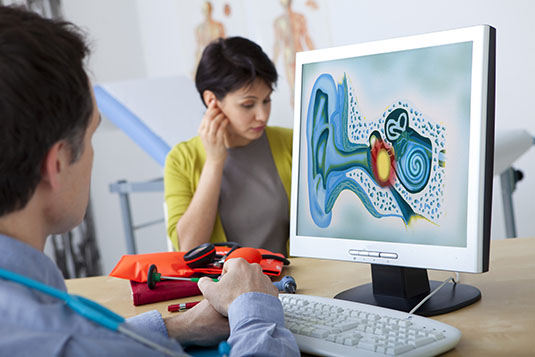Eustachian Tube Dysfunction and Balloon Dilatation
Eustachian tube dysfunction (ETD) can be defined as pressure abnormalities in the middle ear which result in dulled hearing and a feeling of pressure in the affected ear.
While it is often a temporary problem during a cold, there are other causes. In many cases no treatment is needed although decongestants, antihistamines or a steroid nasal spray sometimes help. In some cases surgery is required.
The Eustachian tubes are small tubes that connect the middle ear (the space behind the eardrum) to the back of the nose. The main functions of the eustachian tubes are:
- To allow pressure to equalise between the outside world and the middle ear cavity
- Allow fluid to drain from the middle ear
- Protect the middle ear from infections and disease
When the eustachian tube malfunctions, patients can feel like their ears are constantly blocked or under pressure. Whilst most eustachian tube dysfunction resolves on its own, there are interventions which may help patients with chronic symptoms.
Symptoms of dysfunctional eustachian tube
Symptoms of a dysfunctional eustachian tube may include
- Feeling of fullness
- Feeling of pressure
- Muffled sound
- A tickling or clicking sensation
- Ear pain
- Ringing in the ears – also known as tinnitus
- Symptoms worsen with flying or traveling to higher altitudes
What causes eustachian tube dysfunction?
There’s no single cause for ETD. An ENT specialist (otolaryngologist) will conduct a physical assessment and evaluate symptoms to form a diagnosis and treatment plan.
Some possible causes are:
- Anatomy – particularly in children, the eustachian tubes are more horizontal than adults, This can result in drainage issues which may lead to blocked eustachian tubes, recurrent ear infections and glue ear.
- Septal deviation – A bent nasal septum may result in nasal inflammation that blocks the eustachian tubes
- Swelling – nasal allergies, common cold, sinus infections or other upper respiratory tract infections
Eustachian tube dysfunction treatment
The team at ENT Specialists Group offer a range of treatment options for eustachian tube dysfunction. Our goal is to help determine the most effective treatment plan for your needs. Treatments range from nasal decongestants, nasal steroids and exercises to surgery.
Surgical treatment for eustachian tube dysfunction
The primary goal of surgical treatment is to bypass the eustachian tube in order to ventilate the middle ear. Surgery can restore hearing, relieve pressure sensation in the ear and reduce the tendency for middle ear infections.
Balloon dilatation
Eustachian tube balloon dilatation (ETBD) is a low-risk procedure that can be performed to clear the eustachian tube. This helps to reduce inflammation and ear pressure.
During this surgery an endoscope is passed through the nose to the opening of the eustachian tube and a small balloon is placed into the eustachian tube. The balloon is then inflated to open up the eustachian tube. After the procedure, the balloon is then deflated and removed. The procedure has very few risks and has no requirement for time off work or painkillers after the procedure
Complications from untreated ETD:
- Ear infections / otitis media
- Damage to the middle ear
- Damage to the eardrum
- Eardrum perforation
- Hearing loss
- Vertigo
- Growths behind the eardrum called cholesteatoma
Our ENT Specialist team
Our team is highly regarded in the field of eustachian tube dysfunction and balloon dilatation.
Mr Yi Chen Zhao
- Nasal allergy and immunotherapy specialist
- The nose specialist and current head of nasal and sinus surgery at the Royal Victorian Eye and Ear Hospital.
- Specialist at the Royal Melbourne Hospital and St Vincent’s Hospital with the neurosurgeons that perform operations from the nose to the brain
Mr. Nathan Hayward
- ENT surgeon in Melbourne
- Unique expertise in sleep and snoring surgery
- Works with respiratory physicians to specialise in sleep studies and sleep apnoea
Mr. Sam Flatman
- ENT surgeon in Melbourne and visit Gippsland.
- Works at Peter MacCallum Cancer Centre treating head and neck cancers.
Mr. Tim Baker
- Experienced head, neck and rhinoplasty surgeon
- 20 years’ experience in all aspects of ENT specialising in rhinoplasty and head and neck cancers
What to expect from your consultation
Before progressing with any treatments at ENT Specialist Group, we want you to have all the information you need to make an informed decision and know exactly what to expect.
There is no single treatment for severe nosebleeds as every case is different. Some patients may experience relief from non-surgical options while others may require surgery.
Fast appointments
We’re HotDoc integrated which means you can book and schedule an appointment online or via mobile any time of night or day. We aim to accommodate urgent GP referrals within 24 hours.
What happens next?
If you’re in Melbourne or regional areas of Victoria and you’re concerned about epistaxis we invite you to contact us for a consultation. We will discuss all your options and help you feel empowered to take the next step.
Where can I make an appointment to discuss nasal cautery and other nosebleed treatments?
To help ensure our services are accessible for all Victorians, We consult at various locations across metropolitan Melbourne and regional Victoria.
Visit us at:
- Heidelberg
- Bendigo
- Shepparton
- Sale
- Wantirna
If you’d like to understand more about treatment and surgical options, contact us today or make an online booking.


